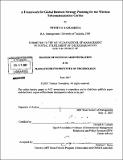A framework for global business strategy planning for the wireless telecommunication carrier
Author(s)
Yamashita, Tetsuya
DownloadFull printable version (5.128Mb)
Other Contributors
Sloan School of Management.
Advisor
Donald R. Lessard.
Terms of use
Metadata
Show full item recordAbstract
Within 27 years from 1979 when the first analogue cellular telephone system was launched, the Wireless Telecommunication industry has evolved drastically. Its technology and service are now in third generation: 3G, and already moving forward to 4G. Within a few years, it will enable the exchange of multimedia contents with huge digital data over the air. In the global market, most countries have deregulation and encourage now free competition. Especially emerging market e.g. BRICS is rapidly growing and intensifying the global competition. Furthermore, it seems that the internet revolution forces the industry to change their traditional business model entirely. In this situation, wireless telecom carriers may not be able to survive if they fail to adapt to the new evolved environment. They need developing an appropriate global business strategy, taking into account all complex essential factors: integration with the internet, sustainable disruptive innovation, international technology standardization and market globalization. What framework and method can solve the problem? (cont.) This is the essential question for the industry. In order to answer the question, I believe that any player in the industry has to investigate these dynamics and interrelation each factor has, and design business strategy to achieve sustainable growth in the complex market. In the thesis, as one part of the solution, I propose (i) a hybrid analysis method how to investigate the industry and capture the complex dynamics, and (ii) strategy development procedure to support appropriate business strategy for future wireless communication business. In terms of (i), I introduce three analysis tools: my Triangle Pyramid Configuration Study (TPCS), Porter's Competitive Advantage Analysis and Lessard's RATs Test. Regarding to (ii), I clarify a scheme to integrate these analyses results obtained by (i) for the business strategy development. Finally, I conclude my research by describing essential issues for future wireless telephony business.
Description
Thesis (M.B.A.)--Massachusetts Institute of Technology, Sloan School of Management, 2007. Includes bibliographical references (leaf 96).
Date issued
2007Department
Sloan School of ManagementPublisher
Massachusetts Institute of Technology
Keywords
Sloan School of Management.